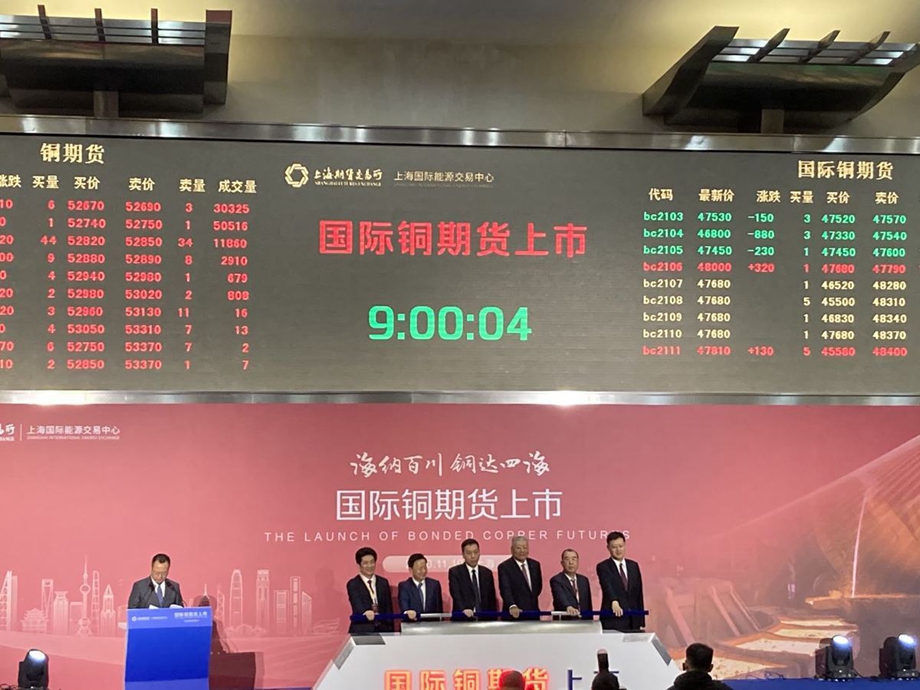Shanghai exchange unveils copper futures product

The bonded copper futures contract which is open to foreign traders started trading at the Shanghai International Energy Exchange on Nov 19, 2020. [Photo by Shi Jing/China Daily]
Bonded copper futures open to overseas investors started trading at the Shanghai International Energy Exchange on Thursday, a move that experts said will help enhance China's pricing power over commodities and promote the internationalization of the renminbi.
As a result, major overseas trading platforms including CQG, Tradex and Bloomberg now have access to the futures product.
This is the fourth international futures product that the exchange has launched. Yuan-denominated crude oil futures, unveiled in 2018, were the exchange's first international product, followed by rubber and low-sulfur fuel oil futures.
In a speech delivered on Nov 12 at a grand gathering in Shanghai to celebrate the 30th anniversary of the development and openingup of Pudong New Area, President Xi Jinping said efforts should be made to enhance the area's influence on the pricing of commodities in order to better serve and lead the development of the real economy.
The new product will also help to serve the country's "dual-circulation" development model, said Fang Xinghai, vice-chairman of the China Securities Regulatory Commission.
According to the communique of the Fifth Plenary Session of the 19th Central Committee of the Communist Party of China, the nation will stimulate its domestic market and let the domestic and international markets boost each other.
The Shanghai Futures Exchange, the parent institution of the Shanghai International Energy Exchange, launched copper futures in 1993.
The existing copper futures at the exchange have mainly reflected domestic supply and demand for refined copper. The bonded copper futures launched on Thursday are designed to reflect copper supply and demand in international markets.
Therefore, a "dual contract" model has been adopted at the exchange for copper futures.
"The dual contract model is another exploration concerning the opening-up of existing futures products. It is of great importance to the deeper integration of domestic and overseas copper industrial and supply chains," said Fang.
According to the World Bureau of Metal Statistics, total global consumption of copper reached 23.82 million metric tons in 2019, while China was the largest consumer and producer of copper.
Shanghai Futures Exchange Chairman Jiang Yan said that while the exchange's existing copper futures have become a benchmark for spot copper trades in China, they are less internationalized. The dual contract model will better allocate resources in the domestic and international markets, while seeking new opportunities in global cooperation, he said.
Institutional investors with a balance of no less than 100,000 yuan ($15,240) or an equivalent foreign currency balance in their respective margin account for five consecutive business days are allowed to apply for a trading code or trading access for the bonded futures. Individuals meeting the same margin account requirement are also eligible for trading.
Nine futures contracts are the first to be included in the bonded copper futures trading. The daily price fluctuation limit is set at 6 percent. During its debut on Thursday, the March contract closed at 47,010 yuan per ton, down 1.4 percent from the listing price of 47,680 yuan.
Shen Chun, deputy general manager of Jinrui Futures, said that it is unnecessary to be overly concerned by the intraday price fluctuation. Consumption of copper may remain sluggish these days due to the impact of the COVID-19 pandemic. In the longer term, copper will help to evade inflation risks based on past experience.
"More important, the introduction of bonded copper will advance the internationalization of the capital market," he said.
Fang from the CSRC said that bonded copper is very likely to become one of the pricing benchmarks in the Asia-Pacific region, which will help enhance China's influence in the pricing of commodities in general and promote the internationalization of the renminbi.